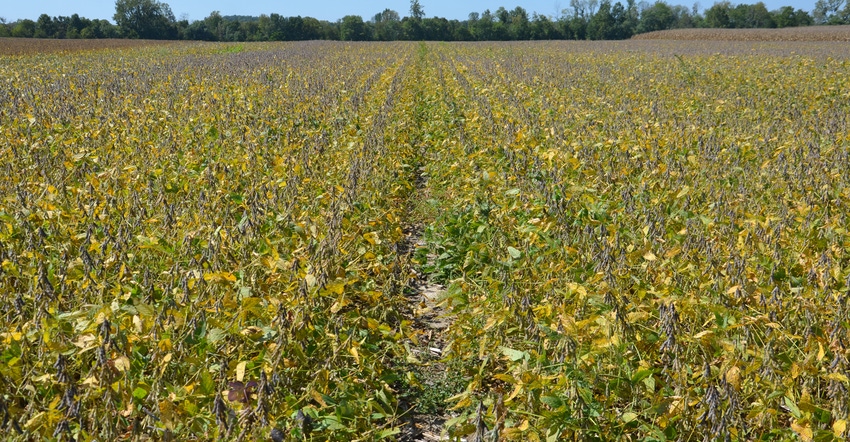
Once 2020 soybeans are harvested, you can begin thinking about next year. Until then, don’t assume the crop is finished packing in yield. Especially if it turns dry and you have irrigation, don’t give up on soybeans too soon. Agronomists say you might be leaving yield potential behind.
Many soybeans in the Midwest were planted early or on time this year. However, the Soybean Watch ’20 field was in an area that had a spring somewhat like 2019, just not as severe. The field was no-tilled into heavy cornstalk residue in 15-inch rows on June 6. When Steve Gauck visited the field in early August, soybeans were between the R3 and R4 reproductive stages.
“There are other fields planted earlier that may have been somewhat further along, but these soybeans should mature in good fashion well ahead of any potential early frost,” says Gauck, regional agronomy manager for Beck’s, sponsor of Soybean Watch ’20. “Soybean maturity is tied partially to photoperiod, so even if you plant in early June, as long as weather patterns are reasonably normal, they will mature close to the normal time.”
Soybeans in the R3 and R4 reproductive stages are producing pods, Gauck explains. According to the Purdue University Extension Corn & Soybean Field Guide, soybeans at R3 have pods that are at least a quarter inch long on one of the four uppermost nodes on the main stem with a completely unrolled leaf. At R4, pods in that position are three-quarters of an inch long.
“These were in between, but the crop is well-positioned to finish strong,” Gauck says. “It’s important to scout and control insects all the way to maturity today, because once modern varieties begin filling pods, they continue as long as possible. In this particular field, it helps because irrigation is available. The operator used it to help soybeans emerge in a dry spell. He hasn’t used it since, but it is available if needed.”
Water requirements
Betsy Bower, an Indiana certified crop adviser like Gauck and an agronomist with Ceres Solutions in west-central Indiana, says for maximum performance, soybeans need moisture later into the season than you might think.
At R5, as soybeans form inside pods, Bower notes that according to precision irrigation company CropMetrics, they still need 6 inches of water to reach top yield potential by maturity. At R6, as seed enlargement ends, they still need 3 inches. And believe it or not, at R6.5, as leaves begin to yellow, they still need 1.9 inches of water before maturity. That’s only an estimated 10 days from final maturity.
“I’ve been asked if that can be correct, and I say, yes, it can,” Bower says. “As soybeans start to yellow, they still have pretty green pods. When pods start to yellow, then soybeans are nearly finished.”
Bower adds that based on information from CropMetrics, soybeans with leaves beginning to turn yellow that still needed moisture but were not watered gave up 10 bushels per acre compared to soybeans at the same stage that were watered through irrigation.
Bower and Gauck agree that when it comes to soybeans and potential yield, “it’s not over until it’s over.” Gauck adds, “That’s why we emphasize continuing to scout all the way to harvest, just to make sure you get full yield potential.”
About the Author(s)
You May Also Like




